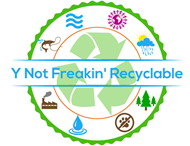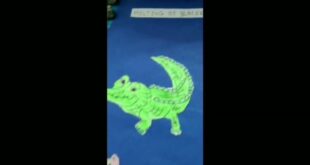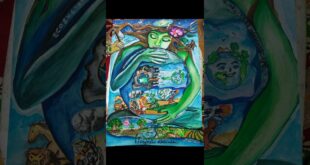[ad_1]
Vital River restoration: Fresh 2020 vision: mission to save our nature – return abundant life by cleansing the Earth’s riverine arteries
Our planet is in deep trouble, water holds the keys to save it, it is up to us to help our magical natural world to survive.
As we mark yet another passage our planet has completed in its spinning journey around the sun- our time is running out before the climatic tipping point is reached. This last decade was globally the most environmentally destructive ever, we must take action in the next one to save our doomed world. Traveling through space on our self-contained Earth ship, flying so effortlessly that we forget that we’re hurtling at astronomical speeds, protected only by our thin layer of hard-won ancient atmosphere from the cold harshness of space, we’re all interdependent. The death throes of the global capitalism which has enslaved us, now threatens to consume the last nature. Business and politics turned us into consumers, we must free ourselves, take the power back. It is up to the people now to save the planet, by building unstoppable movements of positive change, we can free our fellow species and secure our future in harmony with the planet.
Global warming
Our position is becoming more precarious – the coming years will be defined by the element of water, which due to human action has become unbalanced. The imbalance of either too much or too little is already being felt, each year temperature records soar, causing the thawing of permafrost and melting of glaciers and polar ice caps resulting in rising sea levels. Our country is even more vulnerable and the effects of climate change are more pronounced. Vast tracts of forests and bush are burning down, consumed in apocalyptic flames. We have awakened the wrathful and destructive fire gods while trying to steal and harness their power, stoked fiery furnaces to manufacture our excesses and luxuries, to these objects and lifestyles we cling as our earth ship goes down. We keep feeding our monstrous creations that threaten to consume all life – spawned by the horrors of the industrial revolution, we must stop our fossil-fuel addiction immediately to save our world. Like a train hurtling into the abyss, it’s billowing black smoke now consumes our atmosphere and drives up the temperature of our planet.
Our water world
Life on earth flourishes in a very narrow temperature range, one that allows liquid water to exist – the main heat regulator of our planet, it has a memory and our constant mistreatment of water is showing negative effects. Water and the oceans absorb massive amounts of heat, warm water stores less dissolved oxygen and gasses, which negatively affects aquatic ecosystems. Our bodies are similar to the earth, in that they both consist of more than 80% water – equally sensitive to temperature shifts, a fever of a few degrees makes us seriously ill, while anything above that can kill us. Just as it will wipe out most life on earth and decimate our already struggling oceans – shifting climate dooms many species.
Endangered Biodiversity
The sixth great extinction is already upon us and far underway, with a million species now threatened, massive reduction of insect, reptiles, amphibians and fish life. More than 60% of all wildlife gone in the last fifty years, now outnumbered by farmed animals 2:1, to satisfy our desire for meat and dairy, filled with chemicals which sicken our bodies. Animals suffer for nothing, they are not the food our bodies were designed for – difficult to digest it wastes lots of energy and releases further toxins. Forests are destroyed for timber to make way for cruel and unhealthy feedlot industries and Palm oil for snacks, the earth is struggling under the burden of our wasteful lifestyles and harmful greedy desires. The massive population growth is fed by murderous, mechanized mass farming, killing our soil and poisoning our waters with pesticides and chemical fertilizers, causing invasive aliens to flourish. By healing the earth’s vital arteries, many ecosystems can still be saved – our planet’s circulatory system of springs and rivers, as well as clouds and rain, the earth can cool down and maintain the regular temperature in which all life evolved. Her veins are now polluted and lifeless, in this last decade many riverine systems on which billions of animals depend have lost most of their life.
The Rivers of Origin sanctuaries
Modern man has caused havoc to our ancient and magical world where our ancestors lived in harmony for millions of years, restore the place of our origin and heal the soul of mankind. The permanent spring water streams that formed the stable environment that made the long evolution of our species possible in the Cradle, riverbank heritage sites rich in stone-tools, caves and stone structures that point to our first connected culture being along these waterways. To protect the ancient freshwater sources of the Witatersrand, that feed the rivers of Gauteng, the strong fountains on the continental divide that flow in all directions off this High-veld watershed. A forgotten and polluted natural wonder, probably our largest spring water wetland system, and origin of our major river systems, the Crocodile-Limpopo and Vaal-Orange systems, their headwaters declared as strategic water sources – Gauteng has a duty to keep these clean, as pollution spreads from here throughout the country.
The Witwatersrand River Reserves
Protecting and restoring all the perennial Rivers that originate on the Rand from their strong wetland sources to confluence. The Hennops is the most polluted in the system, and our focus and starting point, is a clear example of a thriving ecosystem decimated in seven years, a silent genocide of billions of creatures. Even though most of it’s length flows through natural areas, with it’s lower half through still pristine nature – an area of critical biodiversity. Parts of this area are now protected by the recently declared Crocodile River Reserve, spanning the base areas and confluence of three major Rivers including the Jukskei and numerous streams. Even here there has been massive loss of bio-diversity, insect numbers plummeting, snakes, reptiles and amphibians rarely seen. This ancient area has seen very few changes, air pollution, cellphone towers and urban encroachment can be factors, but the biggest by far is the massive river pollution from upstream. As our primary project we’d like to protect the whole Rivers, extend the reserve’s protection upstream to the sources on the Rand – a first meeting already held and a larger congress is planned for the first part of the year. It will be linked with the Gauteng River Network to try and unify, protect, clean and restore these sources of our major river systems.
Save and restore threatened wetlands
Wetlands are the most endangered freshwater systems, providing habitats for diverse diverse ecosystems. Nature’s most important cleansing systems, they are the best natural purification systems, removing toxins from the water, through micro-organisms living in the roots that are able to break down complex toxic molecules. They are treated with disdain, abused with solid waste disposal, streams filled with plastic and sewerage, all being washed downstream. In the upper Hennops River precious areas like the Kaalspruit, one of our largest, is being filled up and leveled with building rubble for informal housing – thousands living without services, all waste going directly into the streams. Here hundreds of shacks got washed away in the recent flood, many people lost everything in an ignored human disaster, now they are raising foundations and building higher up with brick, still in the flood zone. Jhb municipality is letting the bylaws slide, not stopping this destructive occupation, even though a directive has been issued for its restoration. On the Ekurhuleni side the Duduza stream is filled with rubbish and sewerage that poses a health risk to residents. There are massive sand mining operations a bit lower down, eating away at the banks and exasperating erosion during floods. After this a last natural flood plane area where the Kaalspruit and Clayville tributaries is under threat of imminent development, Rez4 housing with 1200 low cost units planned here, the only official objector is Fresh, although numerous objections from the community have gone missing. This area has massive erosion of more than two stories deep, a directive has been issued and rehabilitation plans are in place, building here will be very dangerous and negatively impact downstream. Similar pollution of plastic and sewerage are also present in the streams at Olievenhoutbosh in Tshwane, residents are actually favoring wetlands as dumping sites.
Drinking water sources in dams
Our country has the highest levels of toxic Cyanobacteria in the world due to eutrophication – high levels of sewerage pollution from improper waste treatment and phosphates from agricultural runoff. this highly toxic algae with Micosystin threatens life and can cause liver damage. The Rietvlei dam, a major drinking water source had a system of Solarium bees to churn the water up and push algae to to the sides, these have not been maintained, with only a few functional, R7million was needed for repairs, now one got washed away, as most have lost moorings and are floating around. Upstream of the dam the Hartebeesfontein Wwtw discharges effuent we’re lobbying for a long artificial wetland to be installed to replace this kilometer long outlet pipe. A wetland will catch many of the toxins that have been found in the dam, substances like hormones, medical waste, heavy metals and endocrine disrupters. We’d like to help facilitate these economic, low maintenance and permanent systems, they should be installed at the outlets of all Wwtw’s to filter the final effluent and remove the many toxins that are accumulating in the environment, and in people’s bodies, causing, suffering, disease and death. Wetlands will boost bio-diversity and save ecosystems to bring back freshwater life. Most of Gauteng’s pollution ends up in the Hartebeespoort dam, which has become hyper eutrophic, very recently the bio-control has started to work very well and most of the Hyacinths are now gone. This will unfortunately opens the space for toxic Cyanobacteria blooms, an even greater problem – if phosphates and pollution are not reduced in the rivers feeding the Dam.
Sewerage pollution
To save our precious resources in a water-scarce country they need to be protected from abuse, we must move away from the enormously costly and wasteful water-borne sewerage system, destroying our world and sickening us, yet seen as a prerequisite of human dignity. The old bucket system worked very well, and could be revived at low cost, it is a very good fertilizer and should be used to enrich the earth, not to poison the water where it doesn’t break down. Portable toilets use strong chemicals and this should be replaced with micro-organisms to start the decomposition, composting toilets and re-using waste water are a good alternative. Sewerage treatment works, they are enormously costly and use huge electricity, a few million Rands per month each, a massive carbon footprint and disabled by load shedding and stolen cables, they are very inefficient and often malfunction. The three WWTW’s on the Hennops have made this River one of the most polluted, foam levels are now at human height in some places, and massive sludge turns water pitch black and putrid in winter.
Solid waste and micro-plastic
Plastic from waste disposal in the water causes it to rot further, clogs the banks, hangs in trees and takes decades to decompose. It breaks down into indestructible micro-plastics that poison us and our world – cheap plastics come at an enormous cost to the health of the environment on which we depend. Our rivers are inundated with trash, this is the origin of most of the huge volumes of plastics in the oceans. Banning single use plastics and styrofoam soon is the only answer, it will boost the economy, create jobs and save our health and nature, there are so many better alternative. The levies on plastic bags should be utilized for recycling and to help ease this transition to a green economy. We’ll keep going with the litter trap nets, at the one on West ave over 300 tons plastic has already been caught and removed here. One needs only three proper functioning trap sites on the different tributaries and have mobilized local groups to take ownership and run projects, to empower communities to run these as independent recycling projects. To restore the ARC weir so that the sediment trap can work again and form a central litter trap, bio-remediation and recycling project run by a local group, this site has great potential, for tourism and agriculture with a picturesque old house and dam.
Collaborative cleanups and restoration,
We’ll be doing cleanup events at certain key places and hotspots to mobilize the people and government in joint action, involve the local community to take responsibility for the upkeep of their River parks and banks, and help them to establish local groups to care for their area. We’ll continue with the goal to form numerous groups operating in their own areas; these can be connected through the Riverine Reserve into a federation whose goal is the protection and the restoration of life along the whole River, united from source to confluence.
Upcoming events programme,
7and 8 February: World wetlands day, cleanup and restoration of River View park, Centurion : installation of a new litter trap net , Bio-remediation agents will be released in Hyacinths chocking upper wetlands of the Hazel stream that flows into the Hennops here. Trolleys will be donated to Bagarezi, boats used to clean the banks and remove plastic from trees. Tree planting, flood damage restoration, wetland renovation, a cultural experience in collaboration with different Ngo’s.
First half, end of March: Rivers of Origin Reserve congress and
Gauteng River Alliance Network inaugural meeting.
Restorative cleanup collaborations: at ARC weir, Eldoraigne, Duduza, Hennops Park and Kaalfontein.
Thanks
Willem Snyman, fresh (Fountains& Rivers Earth Sanctuary – Hennops)
Recent pictures of the state of pollution … See more
Source link
Y Not Freakin’ Recyclable Home
 Pollution Climate Change Holocene Deforestation Population Acidification Y Not Freakin' Recyclable
Pollution Climate Change Holocene Deforestation Population Acidification Y Not Freakin' Recyclable



